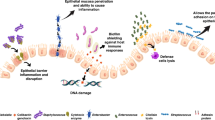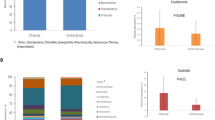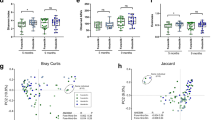Abstract
Newborns adjust to the extrauterine environment by developing intestinal immune homeostasis. Appropriate initial bacterial colonization is necessary for adequate intestinal immune development. An environmental determinant of adequate colonization is breast milk. Although the full-term infant is developmentally capable of mounting an immune response, the effector immune component requires bacterial stimulation. Breast milk stimulates the proliferation of a well-balanced and diverse microbiota, which initially influences a switch from an intrauterine TH2 predominant to a TH1/TH2 balanced response and with activation of T-regulatory cells by breast milk–stimulated specific organisms (Bifidobacteria, Lactobacillus, and Bacteroides). As an example of its effect, oligosaccharides in breast milk are fermented by colonic bacteria producing an acid milieu for bacterial proliferation. In addition, short-chain fatty acids in breast milk activate receptors on T-reg cells and bacterial genes, which preferentially mediate intestinal tight junction expression and anti-inflammation. Other components of breast milk (defensins, lactoferrin, etc.) inhibit pathogens and further contribute to microbiota composition. The breast milk influence on initial intestinal microbiota also prevents expression of immune-mediated diseases (asthma, inflammatory bowel disease, type 1 diabetes) later in life through a balanced initial immune response, underscoring the necessity of breastfeeding as the first source of nutrition.
Similar content being viewed by others
Log in or create a free account to read this content
Gain free access to this article, as well as selected content from this journal and more on nature.com
or
References
Insoft RM, Sanderson IS, Walker WA . The development of immune function within the human intestine and its role in neonatal diseases. Pediatr Clin North Am 1996;43:551–71.
Palmer C, Bik EM, DiGiulio DB, Relman DA, Brown PO . Development of the human infant intestinal microbiota. Plos Biology 2010;5:e1566–73.
Penders J, Thijs C, Vink C, et al. Factors influencing the composition of the intestinal microbiota in early infancy. Pediatrics 2006;118:511–21.
Gareau MG, Sherman PM, Walker WA . Probiotics and the gut microbiota in intestinal health and disease. Nat Rev Gastroenterol Hepatol 2010;7:503–14.
Johnson CL, Versalovic J . The human microbiome and its potential importance to pediatrics. Pediatrics 2012;129:950–60.
Ridaura VK, Faith JJ, Rey FE, et al. Gut microbiota from twins discordant for obesity modulate metabolism of mice. Science 2013;341;1069–70.
Round JL, Mazmanian SK . The gut microbiota shapes intestinal responses during health and disease. Nat Rev Immunol 2009;9:313–23.
Kaplan JL, Shi H, Walker WA . The role of microbes in developmental immunologic programming: convergence of the Barker and hygiene hypotheses. Pediatr Res 2011;9:465–72.
Sellitto M, Bai G, Serena G, et al. Proof of concept of microbiome-metabolome analysis and delayed gluten exposure on celiac disease autoimmunity in genetically at-risk infants. PLoS One 2012;7:e33387.
Cho I, Yamanishi S, Cox L, et al. Antibiotics in early life alter the murine colonic microbiome and adiposity. Nature 2012;488:621–7.
Cotton CM, Taylor S, Stoll B, Goldberg RN, Hansen NI, Sanchez PJ . Prolonged duration of initial empirical antibiotic treatment is associated with increased rates of necrotizing enterocolitis and death for extremely low birth weight infants. Pediatrics 2009;123:59–66.
Kronman MP, Zaoutis TE, Haynes K, Feng R, Coffin SE . Antibiotic exposure and IBD development among children: a population-based cohort study. Pediatrics 2012;130:e794–803.
Marra F, Marra CA, Richardson K, et al. Antibiotic use in children is associated with increased risk of asthma. Pediatrics 2009;123:1003–10.
Kaplan JL, Walker WA . Early gut colonization and subsequent obesity risk. Curr Opin Clin Nutr 2012;15:278–84.
Neish AS . Reviews in basic and clinical gastroenterology: microbes in gastrointestinal health and disease. Gastroenterology 2009;136:65–80.
Walker WA . Bacterial colonization, probiotics and the development of intestinal host defense. Funct Food Rev 2009;1:13–19.
Hill DA, Artis D . Intestinal bacteria and the regulation of immune cell homeostasis. Annu Rev Immunol 2010;28:623–67.
Rautava S, Luoto R, Salminen S, Isolauri A . Microbial contact during pregnancy, intestinal colonization and human disease. Nat Rev Gastroenterol Hepatol 2011;9:565–76.
Artis D . Epithelial-cell recognition of commensal bacteria and maintenance of immune homeostasis in the gut. Nat Rev Immunol 2008;8:411–20.
McAuley JL, Linden SK, Png CW, et al. MUC1 cell surface mucin is a critical element of the mucosal barrier to infection. J Clin Invest 2007;117:2313–24.
Shen L, Turner JR . Role of epithelial cells in initiation and propagation of intestinal inflammation. Eliminating the static: tight junction dynamics exposed. Am J Physiol Gastrointest Liver Physiol 2006;290:G577–82.
Frey A, Giannasca KT, Weltzin R, et al. Role of the glycocalyx in regulating access of microparticles to apical plasma membranes of intestinal epithelial cells: implications for microbial attachment and oral vaccine targeting. J Exp Med 1996;184:1045–59.
Salzman NH, Ghosh D, Huttner KM, Paterson Y, Bevins CL . Protection against enteric salmonellosis in transgenic mice expressing a human intestinal defensin. Nature 2003;422:522–6.
Hooper LV, Wong MH, Thelin A, Hansson L, Falk PG, Gordon JI . Molecular analysis of commensal host-microbial relationships in the intestine. Science 2001;291:881–4.
Hooper LV, Littman DR, Macpherson AJ . Interactions between the microbiota and the immune system. Science 2012;336:1268–73.
Vijay-Kumar M, Aitken JD, Carvalho FA, et al. Metabolic syndrome and altered gut microbiota in mice lacking toll-like receptor 5. Science 2010;328:228–31.
Smith MI, Yatsuneji T, Manary MJ, et al. Gut microbiomes of Malawian twin pairs discordant for Kwashiorkor. Science 2013;339:548–55.
O’Hara AM, Shanahan F . Gut microbiota: mining for therapeutic potential. Clin Gastroenterol Hepatol 2007;5:274–84.
Abreu MT, Fukata M, Arditi M . TLR signaling in the gut in health and disease. J Immunol 2005;174:4453–60.
Otte JM, Cario E, Podolsky DK . Mechanisms of cross hyporesponsiveness to toll-like receptor bacterial ligands in intestinal epithelial cells. Gastroenterology 2004;126:1054–70.
Claud EC, Lu L, Anton PM, Savidge T, Walker WA, Cherayil BJ . Developmentally-regulated IκB expression in intestinal epithelium and susceptibility to flagellin-induced inflammation. Proc Natl Acad Sci USA 2004;101:7404–8.
Neish AS, Gerwitz AT, Zeng H, et al. Prokaryotic regulation of epithelial response by inhibition of IκB-α ubiquitination. Science 2000;289:1560–3.
Kelly D, Campbell JI, King TP, et al. Commensal anaerobic gut bacteria attenuate inflammation by regulating nuclear-cytoplasmic shuttling of PPAR-γ and ReIA. Nat Immunol 2004;5:104–11.
Katakura K, Lee J, Rachmilewitz D, Li G, Eckmann L, Raz E . Toll-like receptor 9-induced type I IFN protects mice from experimental colitis. J Clin Invest 2005;115:695–702.
Cobbold SP, Adams E, Nolan KF, Regateiro FS, Waldmann H . Connecting the mechanisms of T-cell regulation: dendritic cells as the missing link. Immunol Rev 2010;236:203–18.
Niess JH, Brand S, Gu X, et al. CX3CR1-mediated dendritic cell access to the intestinal lumen and bacterial clearance. Science 2005;307:254–8.
Weng M, Walker WA . The role of gut microbiota in programming the immune phenotype. J Dev Orig Health Dis 2013;4:203–14.
Conroy ME, Shi HN, Walker WA . The long-term health effects of neonatal microbial flora. Curr Opin Allergy Clin Immunol 2009;9:197–201.
Macpherson AJ, Uhr T . Induction of protective IgA by intestinal dendritic cells carrying commensal bacteria. Science 2004;303:1662–5.
Guarner F, Bourdet-Sicard R, Brandtzaeg P, et al. Mechanisms of disease: the hygiene hypothesis revisited. Nat Clin Pract Gastroenterol Hepatol 2006;3:275–84.
Nicholson JK, Holmes E, Wilson ID . Gut microorganisms, mammalian metabolism and personalized health care. Nat Rev Microbiol 2005;3:431–8.
Sudo N, Sawamura S, Tanaka K, Aiba Y, Kubo C, Koga Y . The requirement of intestinal bacterial flora for the development of an IgE production system fully susceptible to oral tolerance induction. J Immunol 1997;159:1739–45.
Karlsson MR, Kahu H, Hanson LA, Telemo E, Dahlgren UI . Neonatal colonization of rats induces immunological tolerance to bacterial antigens. Eur J Immunol 1999;29:109–18.
Olszak T, An D, Zeissig S, et al. Microbial exposure during early life has persistent effects on natural killer T cell function. Science 2012;336:489–93.
Bashir ME, Louie S, Shi HN, Nagler-Anderson C . Toll-like receptor 4 signaling by intestinal microbes influences susceptibility to food allergy. J Immunol 2004;172:6978–87.
Pabst O, Mowat AM . Oral tolerance to food protein. Nat Rev Immunol 2012;5:232–9.
Mazmanian SK, Kasper DL . The love–hate relationship between bacterial polysaccharides and the host immune system. Nat Rev Immunol 2006;6:849–58.
Mazmanian SK, Round JL, Kasper DL . A microbial symbiosis factor prevents intestinal inflammatory disease. Nature 2008;453:620–5.
O’Mahoney C, Scully P, O’Mahoney D, et al. Commensal-induced regulatory T cells mediate protection against pathogen-stimulated NF-κB activation. Pathology 2008;4:e1000112.
Atarashi K, Tanoue T, Shima T, et al. Induction of colonic regulatory T cells by indigenous Clostridium species. Science 2011;331:337–41.
Hooper LV . Bacterial contributions to mammalian gut development. Trends Microbiol 2004;12:129–34.
Maslowski KM, Mackay CR . Diet, gut microbiota and immune responses. Nat Immunol 2011;12:5–9.
Hooper LV, Xu J, Falk PG, Midtvedt T, Gordon JI . A molecular sensor that allows a gut commensal to control its nutrient foundation in a competitive ecosystem. Proc Natl Acad Sci USA 1999;96:9833–8.
Arumugam M, Raes J, Pelletier E, et al. Enterotypes of the human gut microbiome. Nature 2011;473:174–80.
Wu GD, Chen J, Hoffmann C, et al. Linking long-term dietary patterns with gut microbial enterotypes. Science 2011;334:105–8.
Faith JJ, McNulty NP, Rey FE, Gordon JI . Predicting a human gut microbiota’s response to diet in gnotobiotic mice. Science 2011;333:101–4.
DeFillippo C, Cavalieri D, DiPaola M, et al. Impact of diet in shaping gut microbiota revealed by a comparative study in children from Europe and rural Africa. Prac Natl Acad Sci USA 2010;107:14691–6.
Shoda R, Matsueda K, Yamato S, Umeda N . Epidemiologic analysis of Crohn disease in Japan: increased dietary intake of n-6 polyunsaturated fatty acids and animal protein relates to the increased incidence of Crohn disease in Japan. Am J Clin Nutr 1996;63:741–5.
Rogier EW, Frantz AL, Bruno ME, et al. Secretory antibodies in breast milk promote long-term intestinal homeostasis by regulating the gut microbiota and host gene expression. Proc Natl Acad Sci USA 2014;111:3074–9.
Rautava S, Walker WA . Breastfeeding—an extrauterine link between mother and child. Breastfeed Med 2009;4:3–10.
Yoshioka H, Iseki K, Fujita K . Development and differences of intestinal flora in the neonatal period in breast-fed and bottle-fed infants. Pediatrics 1983;72:317–21.
Bode L . Human milk oligosaccharides: every baby needs a sugar mama. Glycobiology 2012;22:1147–62.
Sela DA, Mills DA . Nursing our microbiota: molecular linkages between bifodobacteria and milk oligosaccharides. Trends Microbiol 2010;76:7373–81.
Barnes MJ, Powrie F . The guts’ Clostridium cocktail. Science 2011;331:289–90.
Frey A, Giannasca KT, Weltzin R, et al. Role of the glycocalyx in regulating access of microparticles to apical plasma membranes of intestinal epithelial cells: implications for microbial attachment and oral vaccine targeting. J Exp Med 1996;184:1045–59.
Duerr CU, Hornef MW . The mammalian intestinal epithelium as integral player in the establishment and maintenance of host-microbial homeostasis. Semin Immunol 2012;24:25–35.
Geuking MB, Cahenzli J, Lawson MA, et al. Intestinal bacterial colonization induces mutualistic regulatory T cell responses. Immunity 2011;34:794–806.
Smith PM, Howitt MR, Panikov N, et al. The microbial metabolites, short-chain fatty acids, regulate colonic Treg cell homeostasis. Science 2013;341:569–73.
Weng M, Walker WA, Sanderson IR . Butyrate regulates the expression of pathogen-triggered IL-8 in intestinal epithelia. Pediatr Res 2007;62:542–6.
Jost T, Lacroix C, Braegger C, Chassard C . New insights into gut microbiota establishment in healthy breast fed neonates. PLoS One 2012;7:e44595–603.
Garrido D, Kim JH, German JB, Raybould HE, Mills DA . Oligosaccharide binding proteins from Bifidobacterium longum subsp. infantis reveal a preference for host glycans. PLoS One 2011;6:e17315.
Chichlowski M, De Lartigue G, German JB, Raybould HE, Mills DA . Bifidobacteria isolated from infants and cultured on human milk oligosaccharides affect intestinal epithelial function. J Pediatr Gastroenterol Nutr 2012;55:321–7.
Ganguli K, Meng D, Rautava S, Lu L, Walker WA, Nanthakumar N . Probiotics prevent necrotizing enterocolitis by modulating enterocyte genes that regulate innate immune-mediated inflammation. Am J Physiol Gastrointest Liver Physiol 2013;304:G132–41.
Weng M, Ganguli K, Zhu W, Shi HN, Walker WA . Conditioned media from Bifidobacteria infantis protects against Cronobacter seakzakii-induced intestinal inflammation in newborn mice. Am J Physiol Gastrointest Liver Physiol 2014; 306:G779–87.
Schwartz S, Friedberg I, Ivanov IV, et al. A metagenomic study of diet-dependent interaction between gut microbiota and host in infants reveals differences in immune response. Genome Biol 2012;13:r32.
Macpherson AJ, Geuking MB, Slack E, Hepfelmeier S, McCor KD . The habitat, double like, citizenship and forgetfulness of IgA. Immunol Rev 2012;245:132–46.
LeBouder E, Rey-Nores JE, Raby AC, et al. Modulation of neonatal microbial recognition: TLR-mediated innate immune responses are specifically and differentially modulated by human milk. J Immunol 2006;176:3742–52.
Newburg DS, Walker WA . Protection of the neonate by the immune system of developing gut and of human milk. Pediatr Res 2007;61:2–8.
Jeurink PV, van Bergenhenegouwen J, Jiménez E, et al. Human milk: a source of more life than we imagine. Benef Microbes 2013;4:17–30.
Kull I, Melen E, Alm J, et al. Breast-feeding in relation to asthma, lung function, and sensitization in young schoolchildren. J Allergy Clin Immunol 2010;125:1013–9.
Author information
Authors and Affiliations
Corresponding author
Rights and permissions
About this article
Cite this article
Walker, W., Iyengar, R. Breast milk, microbiota, and intestinal immune homeostasis. Pediatr Res 77, 220–228 (2015). https://doi.org/10.1038/pr.2014.160
Received:
Accepted:
Published:
Issue date:
DOI: https://doi.org/10.1038/pr.2014.160
This article is cited by
-
Comparing microbiotas of foals and their mares’ milk in the first two weeks after birth
BMC Veterinary Research (2024)
-
Factors associated with stunting: gut inflammation and child and maternal-related contributors among under-five children in Hawassa City, Sidama Region, Ethiopia
BMC Nutrition (2023)
-
Feeding practice during infancy is associated with attention-deficit/hyperactivity disorder and autism spectrum disorder: a population-based study in South Korea
European Journal of Pediatrics (2023)
-
The gut microbiome of obese postpartum women with and without previous gestational diabetes mellitus and the gut microbiota of their babies
Diabetology & Metabolic Syndrome (2022)
-
Preterm birth and Kawasaki disease: a nationwide Japanese population-based study
Pediatric Research (2022)



